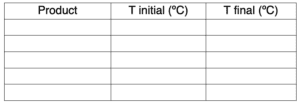Calentamiento o enfriamiento
Objetivo: Experimentar con procesos exotérmicos y endotérmicos

-
Material de laboratorio
Vasos
Termómetros
-
Reactivos
Cloruro amónico (NH4Cl)
Tiosulfato sódico (Na2S2O3)
Hidróxido sódico (NaOH)
Cloruro cálcico (CaCl2)
Urea (CO(NH2)2)
Agua
-
Seguridad
¡¡¡No olvides los guantes, la bata de laboratorio y las gafas protectoras!!!
-
Preguntas
¿Qué procesos son exotérmicos? ¿Y cuáles son endotérmicos?
¿Crees que todos estos procesos son reacciones químicas?
Procedimiento
- Añade 30 mL de agua destilada al vaso de precipitación y mide la temperatura.
- Pesa 5 g del sólido correspondiente, añádelo al vaso de precipitación y mide hasta que el termómetro se estabilice a qué temperatura.
- Rellena la siguiente tabla:

Explicación teórica
Los procesos que liberan calor se denominan exotérmicos y los que absorben calor, endotérmicos. En la primera situación, el recipiente se calienta, y en la segunda, se enfría.
¿Sabías que…? Las compresas frías instantáneas NEXCARE contienen una bolsa interior más pequeña que contiene agua y una bolsa exterior que contiene un sólido blanco, que es urea, CO(NH2)2. Cuando quieras utilizarlas, tienes que darles un fuerte golpe para que se rompa la bolsa interior y se disuelva la urea. Como es obvio, estos envases son de un solo uso.

Creemos un futuro más brillante
Únete a nuestro equipo para trabajar con investigadores de renombre, emprender proyectos innovadores y contribuir a avances científicos significativos.
Únete a nosotros!













